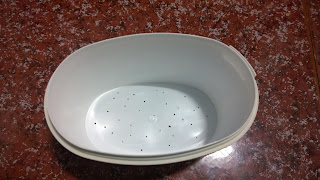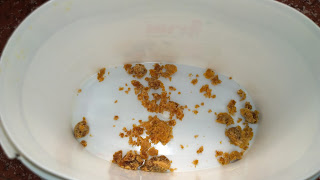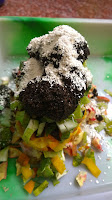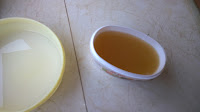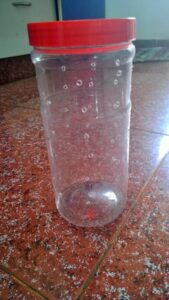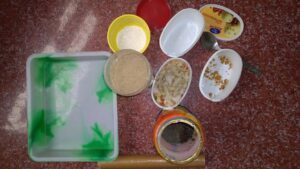Bokashi Composting with DIY container at home.
Bokashi is a Japanese word for fermented organic matter. I tried this method as a test without investing in the bins that are marketed for this purpose. Its a really easy method especially useful for people with space constraints like those of us living in apartments.
Things required:
 |
| Mini Bokashi DIY composter – Setup |
- 2 containers that will fit into each other and with an air tight lid
- Bokashi bran # – Anaerobic microbes that are infused with bran or saw dust
- Organic waste (Any organic waste – including food, meat , etc) (try to avoid too much of bones as they take much longer to compost) I used fruit and vegetable peels, coffee grounds and egg shells powdered *
- Jaggery – 1/4 tsp ( or Molasses )
Method:
1. Drill Holes in one of the containers in the bottom.
2. Add the jaggery to the container with no holes.
3. Put the container with the jaggery at the bottom and the one with the holes on top of it.
4. Put some bokashi bran at the bottom of the container having holes.
5. Now start adding the organic waste and top it with more bokashi bran. In this case, since the container I chose was small, I mixed up all my waste with bokashi bran and filled up the container.
6. Press down the organic matter to compress it well and top it off with more bokashi bran. I used a cling film for this , since I was not sure how air tight the lid was. If you are sure of the air tight lid, then there is no need for the cling film.
7. Close the container and leave it aside for 3-4 days.
8. Check the bottom container for leachate .Remove the leachate and put the bottom container back again. This leachate can be diluted in the ratio of 1:100 i.e 1ml of leachate for 100 ml of water and used to water your plants. The diluted leachate contains a lot of beneficial microbes and works like a magic potion for your plants or leachate poured down your drain will help unclogging your pipes.
9. Continue to remove the leachate every 3-4 days. The amount of leachate you get will depend on the kind of organic matter used.
10. You may notice some white mould / fungus type of growth on your conatiner. This is a good sign. After 2-3 weeks the organic matter will be fermented and you will find a lot of white mould/ fungus.Your 1st stage of bokashi compost is ready.
We need to follow a few basic guidelines while composting using this method.
- This is an anaerobic method in the 1st stage. So we need to make sure that the container used is air tight.
- We need to regularly collect the lechate that comes out, without introducing any air into the container. The lechate will have a strong smell, but not the foul smell of rotten organic matter.
- The end product we get from this process is fermented organic waste and not compost itself,
- This further needs to be processed in stage 2, which is an aerobic process. I used the final product directly in a potting mix. Check this post for details.
# Bokashi bran is available ready made or you can make your own by following this method given
here.
* Powdering the egg shell helps in breaking it down faster.

